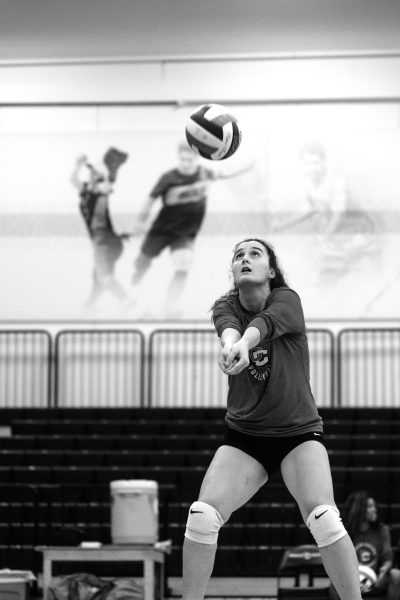Oberlin Should Support Women’s and Men’s Athletics Equally
After attending both women’s basketball and men’s basketball games several times this year, I have begun to notice a disturbing pattern. The women’s basketball team has been playing the earlier game slot this season, while the men’s basketball team plays the later game slot. This has been the case the whole season — with the exception of last Wednesday. The women’s basketball games consistently have lower attendance than the men’s basketball games, and I chalked this up at least partly to the convenience of the time slots. I gave people the benefit of the doubt. However, after last Wednesday, I know that this is not the case.
After the men’s game, which took place at 6 p.m., almost the entire stadium emptied out. Hardly anyone stayed to watch even the first quarter of the women’s game, which started promptly after the men’s game at 8 p.m.
Unfortunately, this is not an isolated incident at Oberlin. After I saw what happened last Wednesday, I began talking to my friends on other women’s sports teams, and have since realized that this is a common experience for pretty much every women’s team on campus. I myself have actually heard players from rival teams joke in the middle of a game about how they had more fans than we did.
The fact that this occurs across all sports indicates that attendance — or lack thereof — has little to do with the record or skill with the teams involved. Several members of the women’s basketball team recall that even when they won the North Coast Athletic Conference championship a couple of years back, they still received a significantly smaller audience than the men’s basketball team. Furthermore, when the women’s basketball team won by 17 points last weekend against the second-seed team in the NCAC, they still had significantly lower attendance than the men’s basketball team that lost by 22 points on the very same day.
There are two problems that the athletes I spoke to and I can pinpoint specifically. First, and most importantly, there is a culture of men’s games being viewed as “events” in a way that women’s games are not. Even when the football team went 0–10 a few years ago, they still received massive crowds. People — especially people who participate in men’s athletics — still tailgated every game, attended games with their groups of friends, and chirped the opponents.
That culture simply does not exist here for women’s sports. There is no reason why people cannot tailgate our games or come and chirp in the same way that they do men’s games. In fact, we would love it if people did. People on women’s sports teams are weary of hearing the same excuses time and time again about why our friends can show up for men’s athletic events, but not ours. There is absolutely no excuse for this double-standard except for a blatant disrespect for and bias against women’s athletics rooted in deeply sexist narratives.
Second, there is an inherent bias in the way that games are scheduled at Oberlin, whether done intentionally or not. Women’s games are almost always before men’s games, which poses several problems. If you look at the current athletics calendar, most of the women’s events are scheduled in the early slot on weekdays, which start between 3 p.m. and 5 p.m. This time slot is extremely inconvenient for numerous reasons. Many people are still in class at this time, as certain classes on weekdays are in session until 4:20 p.m. This is also primetime for other teams’ practices. Almost every sport, whether in season or not, has either practice or lift starting at some point between 4 p.m. and 5 p.m. This means that many athletes couldn’t attend 4 p.m. games even if they wanted to.
Furthermore, most of the women’s games are scheduled for the early slot on Saturdays, too, typically beginning between 10 a.m. and 11 a.m. The early games are also at a distinct disadvantage. Many students don’t typically wake up that early on Saturdays, which certainly affects attendance. But perhaps more importantly is the fact that people are likely to come to the end of the early game and stay for the entirety of the second game. However, women’s sports rarely get the benefit of people staying over between games because we almost always play first.
We have also noticed that, even on special occasions, it seems that women’s games are consistently scheduled to overlap other games. For example, this year, women’s soccer was scheduled for almost every late slot, with just two exceptions — one of which was during Homecoming weekend. Women’s soccer played the early slot, which directly overlapped with both football and volleyball. Whether or not this scheduling was done purposefully, a very clear message was sent: Whoever created the schedules cared more about preventing two men’s athletic events from overlapping than they did about the attendance of the women’s Senior Day soccer game that weekend.
Attendance and crowd engagement has the potential to change the course of games, and this is something that women’s sports do not get to benefit from or enjoy. This is not to say that people never show up for women’s games — this season, the women’s soccer team won a game in double overtime, and much of the team gives credit to the men’s soccer team for showing up and engaging with that game and helping us build momentum.
However, many students who play women’s sports feel that this attendance and engagement is deeply unbalanced. While there are times when attendance is larger at women’s games, this support is sporadic at best. Women’s sports teams are tired of seeing our peers show up for men’s athletic events and not receiving consistent and unconditional support in return.
Many members of women’s athletic teams think the change must start from within men’s athletics. Despite scheduling challenges, members of men’s athletic teams need to start consistently showing support for other women’s teams around campus.
People need to ask themselves why they are able to make time to attend men’s athletic events but not women’s athletic events, especially when the games are back to back. Is it really that you don’t have the time? Or is it that you don’t want to make the time?










